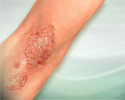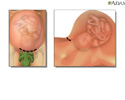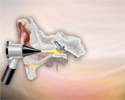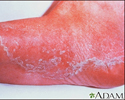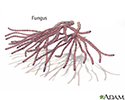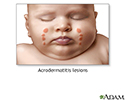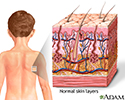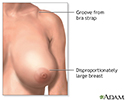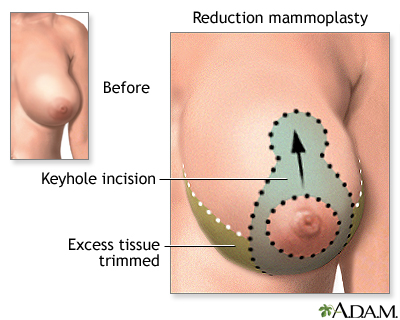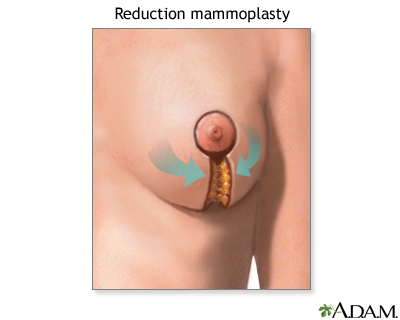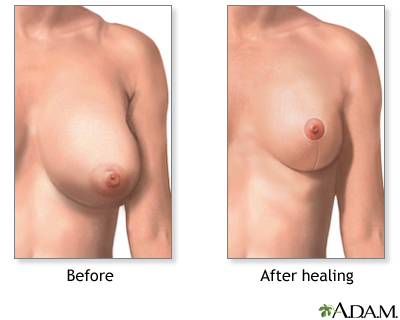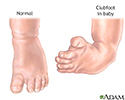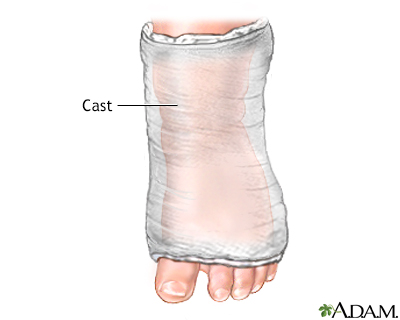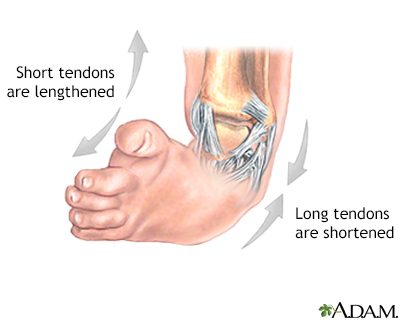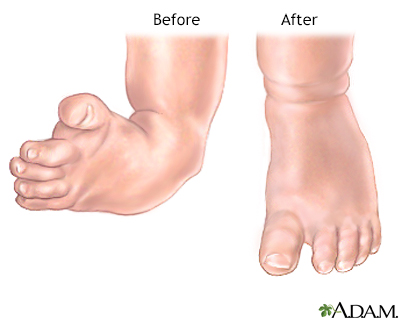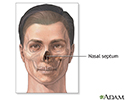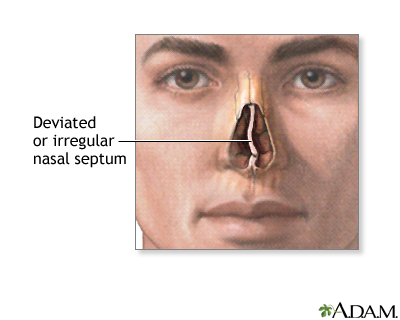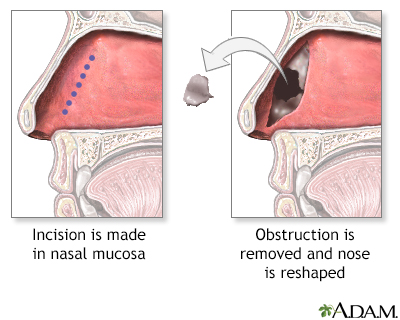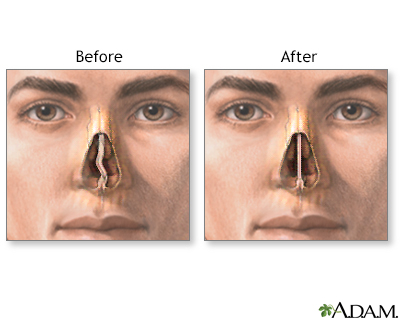Staph infections - self-care at home
Staphylococcus infections - self-care at home; Methicillin-resistant Staphylococcus aureus infections - self-care at home; MRSA infections - self-care at homeStaphylococcus infections - self-care at home; Methicillin-resistant Staphylococcus aureus infections - self-care at home; MRSA infections - self-care at home
The Basics
Tests for Skin infections
A Closer Look
Psoriasis - Animation
Psoriasis
Animation
Systemic lupus erythematosus - Animation
Systemic lupus erythematosus
Animation
Breastfeeding - Animation
Breastfeeding
Animation
Cesarean section - Animation
Cesarean section
Animation
Diabetes - Animation
Diabetes
Animation
Earache - Animation
Earache
Animation
Athlete's foot - tinea pedis
This is a picture of Athlete's foot (tinea pedis). Tinea infection is caused by a fungus that grows on the skin, and is also referred to as ringworm. Cutaneous (skin) tinea infections are often named by their location such as pedis, meaning foot.
Athlete's foot - tinea pedis
illustration
Fungus
Fungal infections are caused by microscopic organisms (fungi) that can live on the skin. They can live on the dead tissues of the hair, nails, and outer skin layers.
Fungus
illustration
Cryptococcosis on the forehead
This is an example of cryptococcus skin lesions on the forehead. Cryptococcus is a yeast (type of fungus) that seldom causes infection and is considered opportunistic (affecting individuals with weakened immune systems). Cryptococcus is one of the more common life-threatening fungal infections in people with AIDS.
Cryptococcosis on the forehead
illustration
Acrodermatitis
Acrodermatitis enteropathica is a skin condition peculiar to children that may be accompanied by mild symptoms of fever and malaise. It may also be associated with hepatitis B infection or other viral infections. The lesions appear as small coppery-red, flat-topped firm papules that appear in crops and sometime in long linear strings, often symmetric.
Acrodermatitis
illustration
Gram stain
A Gram stain is a test used to help identify bacteria. The tested sample can be taken from body fluids that do not normally contain bacteria, such as blood, urine, or cerebrospinal fluid. A sample can also be taken from the site of a suspected infection, such as the throat, lungs, genitals, or skin. Bacteria are classified as either Gram-positive or Gram-negative, based on how they color in reaction with the Gram stain. The Gram stain is colored purple. When combined with the bacteria in a sample, the stain will either stay purple inside the bacteria (Gram-positive), or it will turn pink (Gram-negative). Examples of Gram-positive bacteria include Streptococcus and Staphylococcus aureus, as well as bacteria that cause anthrax, diphtheria, and toxic shock syndrome. Examples of Gram-negative bacteria include Escherichia coli (E coli), Salmonella, Hemophilus influenzae, as well as many bacteria that cause urinary tract infections, pneumonia, or peritonitis. Gram stain can be done within a few hours. The results help providers choose the first antibiotics to use. Cultures of bacteria help identify specific bacteria, but take days to complete.
Gram stain
illustration
Cryptococcus - cutaneous on the hand
These are cryptococcus skin lesions. Cryptococcus is a yeast (type of fungus) that seldom causes infection, but is considered opportunistic (it affects people with weakened immune systems). Cryptococcus is one of the more common life-threatening fungal infections people with AIDS.
Cryptococcus - cutaneous on the hand
illustration
Skin
The skin is the largest organ of the body. The skin and its derivatives (hair, nails, sweat and oil glands) make up the integumentary system. One of the main functions of the skin is protection. It protects the body from external factors such as bacteria, chemicals, and temperature.
Skin
illustration
Breast reduction (mammoplasty) - Series
Presentation
Clubfoot repair - series
Presentation
Septoplasty - series
Presentation
Psoriasis - Animation
Psoriasis
Animation
Systemic lupus erythematosus - Animation
Systemic lupus erythematosus
Animation
Breastfeeding - Animation
Breastfeeding
Animation
Cesarean section - Animation
Cesarean section
Animation
Diabetes - Animation
Diabetes
Animation
Earache - Animation
Earache
Animation
Athlete's foot - tinea pedis
This is a picture of Athlete's foot (tinea pedis). Tinea infection is caused by a fungus that grows on the skin, and is also referred to as ringworm. Cutaneous (skin) tinea infections are often named by their location such as pedis, meaning foot.
Athlete's foot - tinea pedis
illustration
Fungus
Fungal infections are caused by microscopic organisms (fungi) that can live on the skin. They can live on the dead tissues of the hair, nails, and outer skin layers.
Fungus
illustration
Cryptococcosis on the forehead
This is an example of cryptococcus skin lesions on the forehead. Cryptococcus is a yeast (type of fungus) that seldom causes infection and is considered opportunistic (affecting individuals with weakened immune systems). Cryptococcus is one of the more common life-threatening fungal infections in people with AIDS.
Cryptococcosis on the forehead
illustration
Acrodermatitis
Acrodermatitis enteropathica is a skin condition peculiar to children that may be accompanied by mild symptoms of fever and malaise. It may also be associated with hepatitis B infection or other viral infections. The lesions appear as small coppery-red, flat-topped firm papules that appear in crops and sometime in long linear strings, often symmetric.
Acrodermatitis
illustration
Gram stain
A Gram stain is a test used to help identify bacteria. The tested sample can be taken from body fluids that do not normally contain bacteria, such as blood, urine, or cerebrospinal fluid. A sample can also be taken from the site of a suspected infection, such as the throat, lungs, genitals, or skin. Bacteria are classified as either Gram-positive or Gram-negative, based on how they color in reaction with the Gram stain. The Gram stain is colored purple. When combined with the bacteria in a sample, the stain will either stay purple inside the bacteria (Gram-positive), or it will turn pink (Gram-negative). Examples of Gram-positive bacteria include Streptococcus and Staphylococcus aureus, as well as bacteria that cause anthrax, diphtheria, and toxic shock syndrome. Examples of Gram-negative bacteria include Escherichia coli (E coli), Salmonella, Hemophilus influenzae, as well as many bacteria that cause urinary tract infections, pneumonia, or peritonitis. Gram stain can be done within a few hours. The results help providers choose the first antibiotics to use. Cultures of bacteria help identify specific bacteria, but take days to complete.
Gram stain
illustration
Cryptococcus - cutaneous on the hand
These are cryptococcus skin lesions. Cryptococcus is a yeast (type of fungus) that seldom causes infection, but is considered opportunistic (it affects people with weakened immune systems). Cryptococcus is one of the more common life-threatening fungal infections people with AIDS.
Cryptococcus - cutaneous on the hand
illustration
Skin
The skin is the largest organ of the body. The skin and its derivatives (hair, nails, sweat and oil glands) make up the integumentary system. One of the main functions of the skin is protection. It protects the body from external factors such as bacteria, chemicals, and temperature.
Skin
illustration
Breast reduction (mammoplasty) - Series
Presentation
Clubfoot repair - series
Presentation
Septoplasty - series
Presentation
Staph infections - self-care at home
Staphylococcus infections - self-care at home; Methicillin-resistant Staphylococcus aureus infections - self-care at home; MRSA infections - self-care at homeStaphylococcus infections - self-care at home; Methicillin-resistant Staphylococcus aureus infections - self-care at home; MRSA infections - self-care at home
The Basics
Tests for Skin infections
A Closer Look
Staph infections - self-care at home
Staphylococcus infections - self-care at home; Methicillin-resistant Staphylococcus aureus infections - self-care at home; MRSA infections - self-care at homeStaphylococcus infections - self-care at home; Methicillin-resistant Staphylococcus aureus infections - self-care at home; MRSA infections - self-care at home
The Basics
Tests for Skin infections
A Closer Look
Review Date: 7/8/2023
Reviewed By: Linda J. Vorvick, MD, Clinical Professor, Department of Family Medicine, UW Medicine, School of Medicine, University of Washington, Seattle, WA. Also reviewed by David C. Dugdale, MD, Medical Director, Brenda Conaway, Editorial Director, and the A.D.A.M. Editorial team. Editorial update 02/12/2024.

